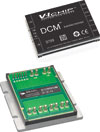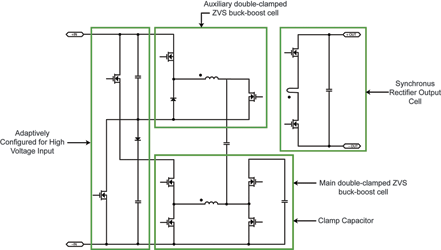
Electric cars outsold those with internal combustion engines (ICE) in the early 1900s but 20 years later, they had all but disappeared. Now, in response to high gas prices and mandated emission and fuel performance standards, they are coming back. Some of them are manufactured by automakers and some are conversions from an ICE car to electric vehicles, but in any vehicle with a higher battery voltage than traditional vehicles, DC-DC conversion is an integral part of automotive power electronics.
Conventional technologies
At present, of course, DC-DC converters employ existing technological designs, one fundamental aspect of which is topology. DC-DC converters employ many different topologies, none of which is superior to all others in every respect. Some applications have requirements that are best satisfied by a specific topology. Although full consideration of the large number of topologies available could be a daunting task, it is helpful to consider the advantages and disadvantages of the two main topological classes: fixed frequency pulse width modulation (PWM) and variable frequency quasi-resonant zero current switching (ZCS).
Of the two, PWM can be somewhat simpler in design, but it inherently trades off efficiency against operating frequency, both important parameters for electric vehicles (EV) or hybrids (HEV). High-frequency operation has long been recognised as one of the main keys to achieving high power density – thanks to smaller magnetics, filters and capacitors – in switchmode converters. With fixed frequency switch mode converters, however, switching losses increase directly with operating frequency, resulting in a ‘frequency barrier’ which limits achievable power density. Variable frequency converters overcome the frequency barrier by having each turn-on and turn-off of the switch occur at zero current. Such converters operate at frequencies in excess of 1 MHz and can achieve power densities considerably greater than low-frequency converters.
A second major difference between fixed frequency and variable frequency DC-DC converters is the noise generated by the switch – again, an important parameter for EVs/HEVs The hard switching of the PWM generates more noise than the soft switching of ZCS.
Today, the primary EV/HEV DC-DC converter application seems to be conversion from a high-voltage battery down to the 12 V typical car voltage, although higher voltages, such as 42 V for power steering, may be required. DC-DC converters – generally customised – used in this application typically have inputs of 250–450 V, outputs of 13, 24 and 28 V, and output powers from 250 W to 3,5 kW. The sizes and weights of available DC-DC converters vary substantially, dependent on the operating frequency, of course, but also to some extent on the inputs and outputs of voltage and power.
With conventional topologies, efficiencies are typically mid-80s to 90%, but the low line efficiencies are likely to be perhaps four or five percentage points lower. As a result, AC-DC and some wide-range DC-DC products need to be derated at the low line.
High-voltage/high-power conversion in vehicles is in an early stage. Many technical and economic challenges must be solved for EV and HEV applications. The technical challenges for such a converter – many of them interrelated - include size, weight, efficiency, electromagnetic compatibility/electromagnetic interference (EMC/EMI), reliability, high-voltage isolation, heat removal/ thermal management and cost. In addition, of course, reliable performance in the parameters of heat, cold, shock and vibration experienced by a road vehicle is a necessity.
Advanced technologies
DC-DC converters for future EVs and HEVs require high power density, efficiency and scalability that cannot be cost-effectively supported by low-frequency, bulk converter designs. While a 2 kW DC-DC converter may be a common design target, high-end vehicles require more power, whereas smaller DC-DC converters with lower power ratings would provide lower cost for entry-level EVs and HEVs. To cope with this breadth of power needs, a flexible, scalable power system methodology using high power density, modular converters capable of efficient bus conversion, isolation and voltage regulation will enable greater performance and faster time to market, cost-effectively.
Such advanced technologies are available or coming on line now. These power conversion engines can support efficient high-voltage electric power distribution within vehicles and provide key advantages to the power system designer, including small size, low weight, high power density, high efficiency, design flexibility and fast response to changing electrical demands.
Specifically, new power conversion technologies – in the form of DC-DC power conversion engines – that promise advanced solutions for EV/HEV vehicles include:
* Zero-voltage switching (DC/ZVS) DC-DC converters with 95% efficiency at 61 W/cm³ power density.
* ZVS buck-boost regulators with >97% efficiency at 61 W/cm³.
* Sine amplitude converter high-voltage (SAC HV) bus converters with 97% efficiency at 61 W/cm³.
DC/ZVS DC-DC converters. Double clamp zero-voltage switching (DC/ZVS) converters (Figure 1) have the capability of providing a regulated output from a very wide input range. Adaptive cell power systems involve a multiplicity of converters that are configured in an array to provide wide-range, high-voltage, high-frequency power processing. A converter block typically utilises two magnetically coupled converter cells that are selectively configured in series or parallel. In either configuration, common-mode noise is essentially cancelled, eliminating a major filtering challenge for EVs and HEVs.

Adaptive cell topologies embodied in DC/ZVS DC-DC converters for EV/HEV DC-DC converter performance may include sine amplitude converter (SAC) cells (Figure 2). SAC engines utilise zero-voltage/zero-current switching to eliminate switching losses. By eliminating switching loss, the SAC can be operated efficiently at relatively high frequencies, typically in the MHz range, resulting in smaller product size. High operating frequency allows for miniaturisation of many components, increasing overall converter power density. Soft switching converters operating at high frequency also minimise electromagnetic interference (EMI) and the filtering components required by hard-switching converters operating at low frequency.

The SAC engine is typically used to provide fixed voltage ratio bus conversion with HV isolation. The DC-ZVS engine provides DC-DC conversion with regulation and isolation. Figures 3 and 4 show efficiency and output ripple performance for DC/ZVS converters configured in a multi-kW array.


ZVS buck-boost regulators. ZVS buck-boost regulators provide a regulated output from an unregulated input source. ZVS buck-boost regulators may be used standalone, as non-isolated voltage regulators or combined with SAC current multipliers to create isolated DC-DC converters. The regulator may be ‘factorised’ away from SAC current multipliers to provide increased density at the point of load while supporting efficient power distribution and savings in conductor weight and cost. In combination, these engines enable DC-DC converter systems with significantly higher density, flexibility and efficiency than conventional converters.
ZVS buck-boost regulator capabilities include:
* Input and output voltages up to 650 V d.c.
* Up to 5:1 input voltage range.
* Up to 5:1 voltage step-up/step-down ratio.
* Conversion efficiency up to 98%.
* Scalable from hundreds of watts to kilowatts.
A unique soft switching topology and ZVS control architecture enable efficient HV operation at 1 MHz. Regulators may be paralleled to achieve increased output power. A feature of the regulator control architecture is that its switching sequence does not change in either buck or boost mode; only the relative duration of phases within each operating cycle are controlled to effect voltage step-up or step-down.
SAC HV bus converters. Fixed-ratio converters, which include the SAC HV bus converter, are capable of efficient HV bus conversion. Additional capabilities include:
* Input and output voltages up to 650 V d.c.
* Up to 5:1 input voltage range.
* Current multiplication up to 200X.
* Conversion efficiency up to 98%.
* Scalable from hundreds of watts to kilowatts.
ZVS-ZCS sine amplitude converter topologies with a low Q power train support efficient high-frequency power processing with a fixed frequency oscillator having a high spectral purity and common-mode symmetry, resulting in essentially noise-free operation. The control architecture locks the operating frequency to the power train resonant frequency, optimising efficiency and minimising output impedance. By effectively cancelling reactive components, output impedance can be relatively low. To further reduce output impedance, or for greater power capability, bus converters can be paralleled with accurate current sharing. Quiet and powerful, SAC bus converters provide essentially linear voltage/current conversion with flat output impedance up to about 1 MHz.
In combination, these power technologies promise superior solutions to the technical challenges associated with EVs and HEVs, including small size, low weight, very high efficiency, low EMI, high-voltage isolation, heat management, modularity, design flexibility, scalability and cost. They are easily paralleled to configure fault-tolerant, high-power arrays.
© Technews Publishing (Pty) Ltd | All Rights Reserved